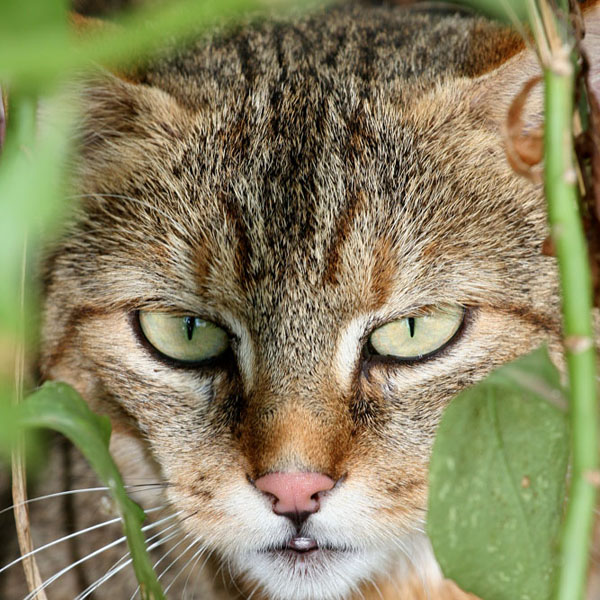
African Wildcat: Secrets of a Mysterious Feline
The African wildcat (Felis silvestris lybica) is a subspecies of the wildcat known for its incredible adaptability and resilience in a wide range of habitats. These small carnivores play a crucial role in controlling rodent populations, which benefits local ecosystems and human communities. The African wildcat is believed to be the ancestral species from which our domestic cats descended, providing a fascinating insight into the evolution of feline companions.
Residing primarily in Africa and the Middle East, these elusive creatures can be found in various habitats, including grasslands, savannas, and deserts. Despite their inconspicuous appearance, African wildcats possess incredible hunting skills and a unique set of physical characteristics that enable them to thrive in their environments. Throughout history, humans have admired these felines for their adaptability and independence, which led to their domestication and the beginnings of a long-standing bond between cats and humans.
Key Takeaways
- African wildcats are resourceful carnivores that play a key role in controlling rodent populations.
- They inhabit a wide range of habitats in Africa and the Middle East, showcasing remarkable adaptability.
- The African wildcat is considered the ancestor of domestic cats, offering valuable insights into feline evolution.
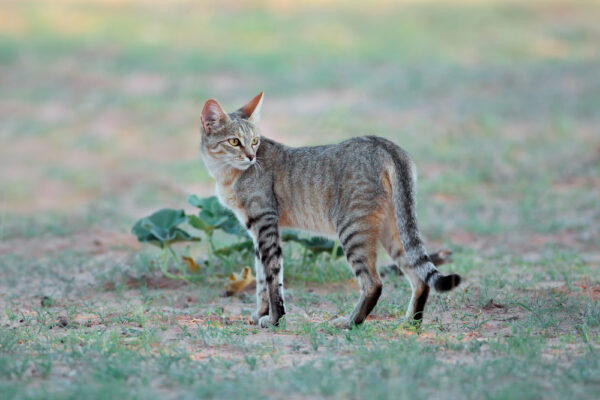
African Wildcat Taxonomy and Scientific Classification
The African Wildcat (Felis lybica) belongs to the kingdom Animalia, which includes all animals. It is classified under the phylum Chordata, as it possesses a notochord during its development. The African Wildcat is a member of the class Mammalia, characterized by the presence of mammary glands, hair, and warm-bloodedness.
Within class Mammalia, the African Wildcat is a part of the order Carnivora, which consists of mammals that primarily have a diet of other animals. More specifically, it falls within the suborder Feliformia, which encompasses the cat-like carnivores. The African Wildcat is a member of the family Felidae, which comprises all the wild cats, including big cats and small cats. Within this family, the African Wildcat is a part of the subfamily Felinae, typically known as the small cats.
The genus to which the African Wildcat belongs is Felis, which includes other small wildcat species. The species name for the African Wildcat is Felis lybica, which distinguishes it from its close relative Felis silvestris, the European Wildcat. The binomial name, Felis lybica, is used to classify and identify the African Wildcat in the scientific community.
In summary, the scientific classification of the African Wildcat is as follows:
- Kingdom: Animalia
- Phylum: Chordata
- Class: Mammalia
- Order: Carnivora
- Suborder: Feliformia
- Family: Felidae
- Subfamily: Felinae
- Genus: Felis
- Species: Felis lybica
The taxonomy of the African Wildcat has been a subject of research and debate, with some authors regarding it as a subspecies of Felis silvestris. However, current research supports the classification of the African Wildcat as a distinct species, Felis lybica.
African Wildcat Physical Characteristics
Coat and Markings
The African wildcat (Felis lybica) has a distinctive coat that features a range of colors, from light sandy shades to grayish-brown hues, depending on its habitat. Its fur is covered in faint stripes and spots, with dark bands encircling the legs and tail. The tail typically has a dark tip and a few darker rings. The ears of the African wildcat are often reddish-orange on the backside, which is a feature that differentiates it from the European wildcat.
Size and Weight
African wildcats are medium-sized cats, with a body size comparable to that of a domestic cat. They have a head-to-body length of approximately 45-75 cm (18-30 inches) and a tail length of 20-38 cm (8-15 inches). Adult males typically weigh between 4-6 kg (8.8-13.2 lbs), while females are slightly smaller, weighing around 3-4 kg (6.6-8.8 lbs).
Anatomy
The anatomy of the African wildcat is built for agility and stealth, with long legs and a slender body. Like other Felis species, they have strong, retractable claws for climbing and capturing prey. Their large ears allow them to have excellent hearing, an essential tool for hunting and detecting predators in their surroundings.
Classification Differences
The classification of the African wildcat has been subject to debate among experts. Within the genus Felis, there are other closely related species, such as the European wildcat, jungle cat, black-footed cat, and domestic cat. The Cat Classification Task Force recognizes the African wildcat as a subspecies (Felis silvestris lybica) of the European wildcat (Felis silvestris), while some authors regard it as a separate species, Felis lybica.
The African wildcat is thought to be the ancestor of the domestic cat, with the two sharing many similarities in appearance and behavior. However, their coat patterns, as well as their size and weight, can help distinguish them from domestic cats.
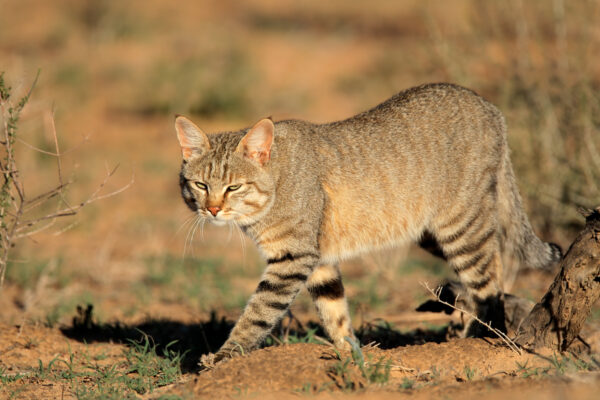
AFrican Wildcat Distribution and Habitat
Geographical Range
The African Wildcat (Felis silvestris) is widely distributed across Africa, with its range extending into parts of Asia and the Arabian Peninsula. In Africa, it can be found from the northern regions down to the southern parts of the continent. While its presence is widespread in North Africa, the population is more fragmented in southern Africa due to various factors such as habitat loss and human activities. The wildcat can also be found in parts of the Middle East and Arabian Peninsula, further showcasing its adaptability to different environments.
Habitat Types
African Wildcats are versatile in the habitats they occupy, making them resilient in a variety of landscapes. They can be found in various habitat types, such as forests, grasslands, and semi-arid areas. Their diverse habitat preferences allow them to adapt to changing environmental conditions and resource availability.
In forests, they prefer areas with dense vegetation cover that provides concealment from predators and offers suitable hunting opportunities for their primarily rodent-based diet. African Wildcats have also been observed in grasslands, where they rely on tall grasses and other vegetation to remain hidden. In dryer, semi-arid regions, they are known to seek shelter and protection in burrows or rocky outcrops.
Despite their adaptability, habitat fragmentation and human-induced changes in the environment pose a threat to the African Wildcat’s distribution and survival. Conservation efforts should continue to ensure the protection of these cats and their habitats, allowing them to thrive within their natural range.
Behavior and Ecology
The African wildcat (Felis silvestris cafra), a small carnivore native to Africa, exhibits unique behaviors and ecological traits that allow it to adapt and survive in its natural environment.
Social Structure
African wildcats are primarily solitary animals. They tend to avoid contact with other members of their species except during mating season. However, some interactions may occasionally occur, such as when they share their territories with neighboring wildcats. This solitary lifestyle contributes to their secretive nature, making them challenging to study in the wild.
Reproduction
Reproduction in African wildcats typically occurs once a year, with the mating season usually taking place between December and March. During this time, male and female wildcats will seek each other out and engage in vocalizations, scent marking, and other behaviors to communicate and establish breeding pairs. Females usually give birth to a litter of two to six kittens after a gestation period of approximately 63 days. The young kittens are born blind and helpless but develop rapidly, reaching independence around four to five months of age.
Diet and Hunting
African wildcats are opportunistic carnivores, primarily feeding on a variety of small mammals, such as rodents, birds, and reptiles. They are skilled hunters, employing various hunting techniques, such as stalking, pouncing, and capturing their prey with incredible stealth and agility. They may also scavenge from larger predators’ kills when the opportunity arises. Their diet provides essential nutrients for their survival and plays a role in the control of small mammal populations in their ecosystems.
Activity Patterns
These wildcats are predominantly nocturnal creatures but are occasionally seen during the day, especially in undisturbed habitats. Their nocturnal habits allow them to avoid competition with larger, diurnal predators such as African lions. This also helps them stay relatively undetected by humans, promoting their overall survival in the wild.
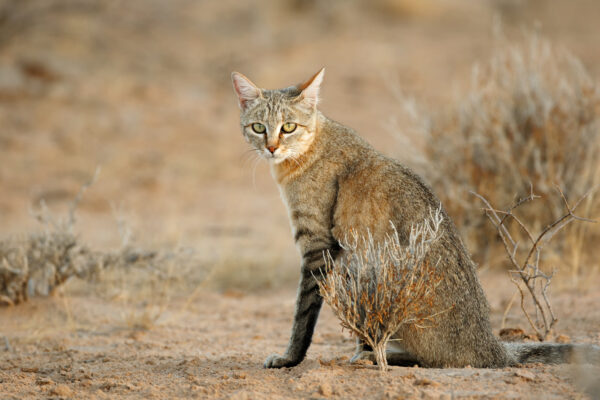
History and Evolution
Domestication
The domestication of the African wildcat, Felis lybica, can be traced back to ancient Egypt, where these cats were highly regarded for their ability to control vermin populations, such as mice and rats. They even became symbols of grace and mystery, as well as guardians of the afterlife. The remains of tamed wildcats in Cyprus, dating back approximately 7500 BC, provide further evidence of the domestication of these felines by Neolithic farmers.
Historical Significance
The African wildcat is a direct ancestor of the modern domesticated cat, as it shares genetic and morphological similarities with its domestic counterparts. Reginald Innes Pocock, a British zoologist, classified the African wildcat as Felis lybica in 1907, highlighting its significance in the evolutionary history of felines. The wildcat also played an essential role in the religious and cultural practices of ancient Egypt, often being associated with several deities and worshiped by the Egyptians.
Genetic Divergence
Recent genetic analyses indicate that African wildcats diverged from a common ancestor less than one million years ago. Their populations split into three main groups: European wildcats (Felis silvestris silvestris), African wildcats (F. s. lybica), and Asian wildcats (F. s. ornata). Despite their close relationship, genetic divergence suggests that these populations have distinct evolutionary histories, with some evidence of admixture and hybridization between them.
| Population | Scientific Name | Range |
|---|---|---|
| European Wildcat | Felis silvestris | Europe and Britain |
| African Wildcat | Felis lybica | Africa and parts of the Middle East |
| Asian Wildcat | Felis ornata | Central Asia |
Scientific Contributions
The study of the African wildcat’s evolutionary history and distribution has contributed to our understanding of cat domestication and genetic divergence among various wildcat populations. Research on the historical interbreeding between wild and domestic cat populations can offer insights into conservation strategies, particularly concerning the genetic integrity of endangered European wildcats. Furthermore, the investigation of the African wildcat’s phylogenetic history and phylogeographic patterns sheds light on the effects of Pleistocene climate changes and recent anthropogenic influences on its populations.
Conservation Status and Threats
Status and Classification
The African Wildcat (Felis silvestris lybica) is a member of the family Carnivora and is classified by the International Union for Conservation of Nature (IUCN) in their Red List as a species of Least Concern in relation to their conservation status. This classification is due to their large distribution range, which extends across most of Africa and parts of Asia. Their adaptability to different habitats also plays a role in this classification. However, this does not mean that the feline is without threats or is not in need of conservation measures.
Hybridization and its Effects
One of the primary threats to the African wildcat is hybridization with domestic cats (Felis catus). This genetic mixing can lead to a loss of the distinct characteristics of the African wildcat, reducing its genetic diversity, and ultimately threatening its survival as a separate species. Hybridization is considered a major concern as domestic cats can spread diseases and affect localized populations of African wildcats. Additionally, both domestic cats and their hybrid offspring can compete with the African wildcats for resources, such as food and territory, which may further contribute to a decline in wildcat population numbers.
Conservation Measures
In an effort to preserve the wild population and protect them from the risk of hybridization and other potential threats, various conservation measures should be implemented:
- Encouraging responsible pet ownership, including the neutering of domestic cats to prevent breeding with African wildcats.
- Establishing protected areas for the African wildcat and its habitat, which can help reduce human-wildlife conflict and ensure the availability of natural prey sources.
- Continuously monitoring and studying the population distribution and dynamics of the African wildcat, allowing for more accurate assessments of their conservation status and tailoring of specific conservation strategies.
- Enforcing the Convention on International Trade in Endangered Species of Wild Fauna and Flora (CITES) regulations that govern the trade of African wildcats and their body parts, which can help curb illegal hunting activities and reduce the demand for wildcat-derived products.
Through these efforts, it may be possible to mitigate the threats faced by African wildcats and ensure the survival of this unique species for future generations.
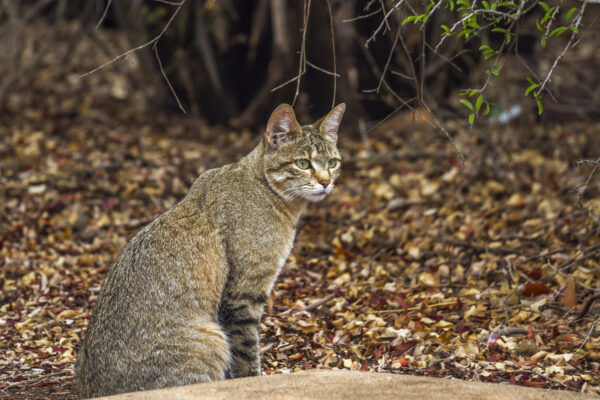
Subspecies of African Wildcat
The African wildcat (Felis lybica) is a felid species that is predominantly found throughout Africa, with its range extending into parts of Asia and Europe. Within this species, there are several recognized subspecies which display varying genetic and morphological characteristics across their geographic distribution.
One of the most notable subspecies is the Southern African wildcat (Felis lybica cafra). This subspecies is primarily found within the southern regions of Africa. Genetic analyses have revealed that the Southern African wildcat is distinct from the domestic cat (Felis catus), showcasing a clear distinction between the two despite potential interbreeding concerns.
Other subspecies of African wildcats include the Asian wildcats (Felis silvestris ornata and related subspecies) and the diverse North African Wildcats group. The Asian subscpecies are typically found in dry, open habitats, whereas the North African Wildcats can be observed in both arid and forested regions, contributing to the high level of diversity within this group.
The origin and classification of African wildcat subspecies have been largely influenced by historic events, such as the Pleistocene climatic fluctuations, which may have led to their diversification. As such, understanding the unique characteristics and distribution of these subspecies is crucial for their conservation and management efforts.
In summary, the various subspecies of the African wildcat exhibit unique genetic, morphological, and geographical features that set them apart within the Felis lybica species. The Southern African wildcat, Asian wildcats, and North African wildcats are some of the most distinctive subspecies, each occupying different ecological niches and facing their own set of conservation challenges.
References and Further Reading
In order to have a deeper understanding of the African wildcat (Felis silvestris lybica), several key resources and studies are essential. One important publication is the book “Wild Cats of the World” which provides a rich source of reference material on African wildcats as well as their European and Asian counterparts.
A study by Gray et al. investigates the craniological differentiation between European, African, and Asian wildcats. This research can be valuable in understanding the evolution and emergence of the modern cat lineages, particularly the steppe wildcat ancestry shared by the Asian and African wildcats.
Moreover, focusing on the African wildcat’s feeding habits, the Kgalagadi Transfrontier Park, located between South Africa and Botswana, has been studied extensively. The park provides insights into the animal’s facultative trophic specialization, showing that male African wildcats generally prefer larger mammals, while females favor birds and reptiles.
To better understand the African wildcat’s behavior, a comparison with other wildcats like the Scottish wildcat (Felis silvestris grampia) could be insightful. Related research in London explores various species’ personalities, providing fascinating connections between wildcats from different regions.
Lastly, while studying the cats’ home range, it is crucial to consider the biogeographic aspects affecting its population. Recent research highlights that European wildcat populations are divided into five main biogeographic groups due to Pleistocene climate changes or anthropogenic factors.
By reviewing these key resources and studies, readers can gain a confident and knowledgeable understanding of the feline’s ecology, behavior, and evolution.
Frequently Asked Questions
What does the African wildcat eat?
The African wildcat primarily feeds on small mammals such as rodents, birds, and hare. They are opportunistic predators and may also consume insects, reptiles, and other available prey in their natural environment.
How does the size o compare to domestic cats?
African wildcats are similar in size to domestic cats, with some slight variations. Adult individuals typically weigh between 3–7 kg (6.6–15.4 lbs) and have a body length of around 50–70 cm (20–28 inches). Domestic cats, on the other hand, can vary significantly in size, with most weighing between 2–7 kg (4.4–15.4 lbs) and having a body length of 45–60 cm (18–24 inches).
Is it possible to keep an African wildcat as a pet?
While it is not illegal in some countries to keep an African wildcat as a pet, it is not recommended. These wild animals have specific needs and behaviors that can be challenging to manage in a domestic setting. Additionally, keeping an African wildcat as a pet can lead to a reduction in their wild populations due to illegal capturing or breeding.
In which habitats can we find African wildcats?
African wildcats can be found in various habitats across the continent, from savannas and grasslands to forests and semi-desert regions. They are highly adaptable and can also inhabit agricultural lands, provided there is enough cover and food sources.
What predators do African wildcats face in the wild?
The main predators of African wildcats are larger carnivores, such as lions, leopards, and hyenas, as well as large birds of prey like eagles. Their small size and evasive behavior make them challenging prey, but they still face threats when encountered by these larger predators.
Are African wildcats still present in the wild today?
Yes, African wildcats are still present in the wild today. However, their population is facing numerous threats, including habitat loss, human-wildlife conflicts, and hybridization with domestic cats. Conservation efforts are being implemented in various parts of Africa to ensure the survival of this unique species.